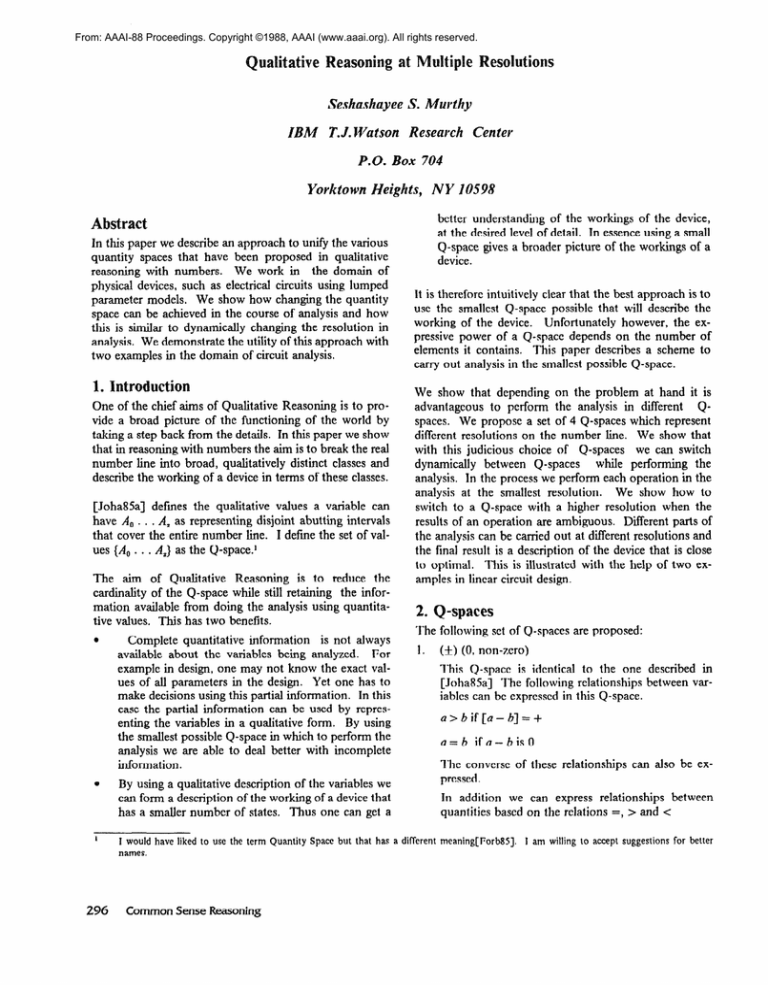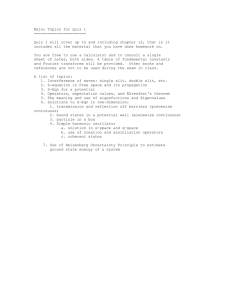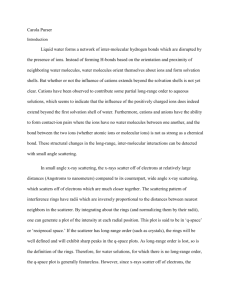
From: AAAI-88 Proceedings. Copyright ©1988, AAAI (www.aaai.org). All rights reserved.
uallitative
Reasoning
at Multi
esolutions
Seshashayee S. Murthy
M
T.J. W&son
Research Center
P.Q. Box 704
Yorktown Heights,
better understanding
of the workings of the device,
at the desired level of detail. In essence using a small
Q-space gives a broader picture of the workings of a
device.
Ah§tI%Nt
In this paper we describe an approach to unify the various
quantity spaces that have been proposed in qualitative
reasoning with numbers.
We work in the domain of
physical devices, such as electrical circuits using lumped
parameter models. We show how changing the quantity
space can be achieved in the course of analysis and how
this is similar to dynamically changing the resolution in
analysis. We demonstrate the utility of this approach with
two examples in the domain of circuit analysis.
1. Introduction
One of the chief aims of Qualitative Reasoning is to provide a broad picture of the functioning of the world by
taking a step back from the details. In this paper we show
that in reasoning with numbers the aim is to break the real
number line into broad, qualitatively distinct classes and
describe the working of a device in terms of these classes.
[JohaGa]
defines the qualitative values a variable can
have A0 . . . A, as representing disjoint abutting intervals
that cover the entire number line. I define the set of values {A, . . . A,) as the Q-space.’
The aim of Qualitative
Reasoning is to reduce the
cardinal&y of the Q-space while still retaining the information available from doing the analysis using quantitative values. This has two benefits.
0
a
Complete quantitative information
is not always
available about the variables being analyzed.
For
example in design, one may not know the exact values of all parameters in the design. Vet one has to
make decisions using this partial information.
In this
case the partial information can be used by representing the variables in a qualitative form. By using
the smallest possible Q-space in which to perform the
analysis we are able to deal better with incomplete
information.
By using a qualitative description of the variables we
can form a description of the working of a device that
has a smaller number of states. Thus one can get a
I would have liked to use the term Quantity
names.
296
Common Sense Reasoning
Space but that has a
NY 10598
It is therefore intuitively clear that the best approach is to
use the smallest Q-space possible that will describe the
working of the device. Unfortunately
however, the expressive power of a Q-space depends on the number of
elements it contains.
This paper describes a scheme to
carry out analysis in the smallest possible Q-space.
We show that depending on the problem at hand it is
advantageous to perform the analysis in different
Qspaces. We propose a set of 4 Q-spaces which represent
different resolutions on the number line. We show that
with this judicious choice of Q-spaces we can switch
dynamically between Q-spaces
while performing the
analysis. In the process we perform each operation in the
analysis at the smallest resolution.
We show how to
switch to a Q-space with a higher resolution when the
results of an operation are ambiguous.
Different parts of
the analysis can be carried out at different resolutions and
the final result is a description of the device that is close
to optimal.
This is illustrated with the help of two examples in linear circuit design.
2.
-spaces
The following set of Q-spaces are proposed:
I.
(&) (0, non-zero)
This Q-space is identical to the one described in
[JohagSaJ The following relationships between variablcs can bc cxpresscd in this Q-space.
a > b if [a - h] = +
a=b
ifa-bis0
The converse of these relationships
pressed.
can also be ex-
In addition we can express relationships
between
quantities based on the relations =, > and <
meaning[ PorbM J.
I am willing to accept suggestions for better
It is significant that the
multiplication.
We show
can result in ambiguity.
resolved by using Q-space
a is increasing if
a(t2) > a(t1) and 12 > tl
The rules for arithmetic are described in [.Toha85a]
It is to be noted that if [a] f [b] then [a + b] is
indeterminate.
Magnitude information is also absent,
This ambiguity can be resolved by moving to the
next Q-space.
2.
(5) (0, infinitesimal,
3.
In this Q-space it is possible to express all the relations that can be expressed in Q-spaces, 1 and 2.
In addition it is possible to describe the logarithmic
distance , LD, between two numbers
large)
LD(a,b)
CalCbl = WI
b(1 +E).
log(a*b) = log(a) + log(b)
or large.
For addition the rules are.
[Mavr87] shows how to tie this Q-space to the real
number line. This is done by choosing a value e that
is the minim urn ratio between a large and a small
number.
If log(a) > log(b) or ([a] = [b]
then2
In the following a, and b, are the thresholds for a and
b.
The rules for addition
are2 described
in
[Raim86].
l[t is to be noted that these rules holds
only if a, = b,.
and
2
[a + b] = [a]
If log(a) = log(b) and
[a] # [b] then
log(a + b) IS log(a)
To resolve the ambiand [a + b] is indeterminate.
guity we need to go to a finer level of resolution, i.e.
the next Q-space.
4.
in this Q-space retains the sign infor-
a x b is large if a is large and b is large
a x b is small is a is small and b is small
Here the threshold is a, x b,
The product is ambiguous is all other cases.
and log(a) = log(b))
log(a + b) = log(a)
Q-space 2 splits the positive half of the real number
line into two halves that are separated by a threshold.
The threshold is different for different types of variables e.g. impedance and frequency.
Even for the
same type of variable the threshold depends on the
particular comparison
being made.
For example
when we say two places are far apart it depends on
whether the journey is being made by car or on foot.
Multiplication
mation.
= log(a) - log(b)
For multiplication.
a $- b if a is large and b is infinitesimal.
a - b if a and b are both infinitesimal
(+)(O, y2) where y is the base, (e.g. 2 or lo), and z
is an integer. Ikre 1 is y”.
If 1a 1 = y’, then log(a) -= z.
This Q-space is identical to the one described in
[Raim86] All relations that can be expressed in Qspace 1 can be expressed in this Q-space. In addition,
relationships
can
be
the
following
expressedCRaim86-J.
Q g bifa=
threshold changes during
in the examples how this
These ambiguities can be
3.
3.
(+)(x * UT), y and z as before and x is a number with
n significant digits. As n increases the veracity of the
description increases till at n= infinity this Q-space
approaches the real number line. The rules for addition and subtraction are similar to that in machine
arithmetic with fixed precision.
e~ations~li~ to previous work.
In this section we illustrate the use of the 4 Q-spaces, with
two examples from the domain of circuit analysis.
We run into Zeno’s paradox here. This can be resolved by going
to the next finer resolution if necessary.
Murthy
297
The (&) (0, non-zero) Q-space [Joha85a, Forb85] has
the lowest resolution.
It is excellent for describing the
working of the circuit in Figure 1 if we merely wish to
discover whether the current I flowing in the circuit increases with V.
I = Vo/R,
If we started out with a more complicated model of a
voltage source that includes an output resistance R, as in
Figure lb WC can use the (j-)(0, infinitesimal, large) Qspace [Raim86] to reason about the quantities. To determine the current flowing in the circuit we use Ohm’s law
to find
I = V/(R, + Ri)
I1 = Vi/R
If R, < R, then R, can be neglected w.r.t R,. i.e.
I2= V2/R
R,+R,=R,
I2 -
I1 = (V2 -
Vl)/R
If V2 > Vl then [V2 - Vl] = +
Therefore
Therefore
I= V/R,
l-12 - 111= + and I increases with V.
Reasoning in the (+)(O, infinitesimal, large) Q-space can
bring about ambiguity if two quantities are multiplied.
Consider the example of Figure lc. Here we represent
the load by a capacitor C in parallel with the load resistance R,. The combination is in series with an inductance
L.
Admittance( R, 11C’) = WC + ljR,[Purc65]
in this equation has its own
Each type of variable
threshold.
That is because different types of variables
have different units. For example, it does not make sense
to compare frequency and resistance.
If we know that
frequency has a threshold o,, resistance has a threshold
R,, and capacitance has a threshold C, it is not necessary
that
Figure
1.
Figure a is a simplified model of a
voltage source in series with a load
In figure b the voltage
resistance R,.
source is represented as an ideal voltage
source
in series with
an output
resistance R,. In figure c the load is
represented by a resistor R, in parallel
with a capacitance C. The whole unit
is in series with an inductance L.
C-p1 = l/R,
even though they have the same units. It is therefore not
possible to compare o C and l/R in this Q-space. It is
also not possible to compare R and CDL,the impedance
of the inductance I,. Hence it is not possible to know if
any of the quantities in the admittance can be neglected.
A threshold must be chosen for each comparison that is
made. In order to do this we need to move to Q-space
5.
Other examples of reasoning in the (+)(O, non-zero)
space can be found in [Joha85b, WillSS] 3 The main
problem with reasoning in this space is that addition of
two numbers of different signs results in ambiguity. Also
it is not possible to neglect small influences w.r.t. big ones.
This is a very important part of Qualitative Reasoning in
humans.
To achieve this capability we need to move to
Q-space 2.
3
298
Using the signs of partials as the elements of an implicit Q-space
is a common technique in economics.
Common Sense Reasoning
If we know that LO- 105, and C- IO-l2 , then oCSimilarly if
R,-
lo”, then l/R,-
10B3
. If WC set the threshold at 1O4, we find that
l/R, g WC
IO-‘.
l/R, + wc=
reasoning
Figure 3
l/R,*
reduces
the
circuit
to
the
one
shown
in
The impedance
of RL 11C is R,, and th
e capacitance
C can be deleted from the model. Hence the current I
flowing through the circuit is
V/(R, + wL + RL)
Here again it is not possible to compare R, and R,. If
we move back to Q-space 3 we fmd that L- lo-lo and its
impedance wL - 1O-5 . If R,- 1O-3 then we can set the
threshold at 104.
L
and
t
R,%&
Hence these two quantities
can be neglected w.r.t. R and
Figure 2.
A positive voltage follower. The top
figure shows the circuit using an
operational amplifier and the bottom is
the model of the operational amplifier.
Figure 3.
The circuit after simplifications reached
by analysis at Q-spaces 2 and 3.
I = V/RL.
Let us now consider an example that has more components. Figure 2 shows the circuit for a positive voltage
follower.
The model for the operational amplifier has the following
parameters:
Bias current
4 - 10-10 A
Input resistance
R,- 10*2n
Input capacitance
C.- lo--l2 F
Cutoff frequency
0: - 107Hertz
Output voltage
v, - 10’ Volts
Gain
K - 102
Output resistance
R,- 10-2n
Biasing resistors
R, and R, - lo5 12
Load resistor
R,- 103f2.
The voltage source has a
v/ 100 Volts,
Voltage
Output resistance
Ri, - 105&J
Frequency
w - 104 Hertz
On analyzing this circuit we fmd that Q-space 2 is not
suflicient to remove ambiguities.
We need to go to Qspace 3 like in the previous example. We fmd that
The equations
for this circuit are
V- = V,(Rl/(Rl
+ R2))
v+ = vi
V,=k(V+-
v-)
f Ience
Therefore Ri can be dropped from the model.
vjwcj g Ib
v+ - I/--
(I/,//t)-
10-l
therefore Zbcan be dropped from the model.
and
Rir<l/wCi
v +- N v-
With these simplifications to the model, the voltage at the
input to the operational amplifier is the same as Vi Similar
If V+ and VP are represented in Q-space 3, or lower, then
the difference is indeterminate.
Murthy
299
5. Conclusions
Therefore to simulate the circuit we need to represent all
the variables in Figure 3 in Q-space 4 with at least 3 significant digits.
The qualitative values a variable can have A, . . . A, as
representing disjoint abutting intervals that cover the entire number line[Joha85a].
I defme the set of values
(A, . . . A,) as the Q-space. In this paper we have proposed a set of 4 Q-spaces that are useful in engineering
problem solving. They allow us to represent the sort of
relations that are useful in making engineering approximations.
The Q-spaces that we describe are chosen because relationships that hold between quantities in Q-space with
lower resolution hold in a Q-space with a higher resolution. If the results are indeterminate going to a Q-space
with a higher resolution may resolve the conflict. Thus
>, < and equal can be represented in all 4 spaces. 9, m
and E can be expressed in Q-spaces 2, 3 and 4. In Qspace 3 and 4 the logarithmic distance between two
number can be expressed. In Q space 4 with n significant
digits we can express the difference of two numbers q, and
q2 where q1 - q2 w lo-”
Q-space 4 has the advantage that it is similar to the way
numbers are represented on machines. There is a calculus
for obtaining error bounds with such arithmetic.
As the
number of significant digits increases this Q-space approximates the real line.
It is possible to have a different break up of the number
line. For example the temperature, We also advocate
choosing the threshold in Q-space 2 dynamically.
Each
comparison involves different quantities and by moving
from Q-space 3 to 2 we are able to set our threshold dynamically.
There is a many-one mapping from Q-space 4 to 3. One
just ignores the significant digits. To go from Q-space 3
to 2 one needs to compare the variable to the appropriate
threshold If
log(q) < log(ihre.s+zoZd)implies q is infinitesimal.
Only the sign is
A device is analyzed at the lowest possible resolution.
If
ambiguities result, we move to a higher resolution Qspace till the ambiguity is resolved. Using this technique
we get as general a description of the device as possible.
300
Common Sense Reasoning
6. Acknowledgements
This paper has benefited greatly from discussions
Peter Blicher, R. Bhaskar and Ruud Bolle.
with
7. References
Forb85.
Forbus,
Kenneth
D.
Qualitative Process
Theory, pages 85- 168. in Bobrow, Daniel G.,
Qualitative Reasoning about Physical Systems.
The MIT Press, 1985.
Joha85b.
de Kleer, Johan.
How Circuits Work, pages
205-281. in Bobrow, Daniel G., Qualitative ReaThe MIT Press,
soning about Physical System.
1985.
Joha85a.
de Kleer, Johan and Brown, John Seely. A
Qualitative Physics based on Confluences, pages
7-84. in Bobrow, Daniel G., Qualitative ReasonThe MIT Press,
ing about Physical Systems.
1985.
Mavr87. Mavrovouniotis,
M. L. and Stephanopoulos,
G.
Reasoning with Orders of Magnitude and approximate relations..
Proceedings of the Sixth
National Conference on Artificial Intelligence, 1,
July 1987.
Purc65. Purcell, 1% M. Electricity and Magnetism..
Graw Ilill book company., 1965.
Raim86.
log(q) > log(ZhreshoZ~ implies q is large.
Moving from Q-space 2 to 1 is trivial.
retained.
We describe a scheme to analyze devices at multiple levels
of resolution.
We propose that 4 Q-spaces be used in
qualitative analysis. These smoothly span the range form
(&) (0, non-zero) to the real-number line. Analysis is
performed at the lowest possible resolution until ambiguities occur. To resolve ambiguities in a Q-space with a
lower resolution, we move to a Q-space with a higher resolution
This paradigm allows us to obtain the most
general description of the working of a device.
MC
Raiman, Olivicr. Order of Magnitude Reasoning.. Proceedings of the Fifth National Conference
on Arti/jcial Intelligence, 1, July 1986.
Will85. Williams, Brian C. Qualitative Analysis of MOS
Circuits, pages 281-347. in Bobrow, Daniel G.,
Qualitative Reasoning about Physical Systems.
The MIT Press, 1985.





